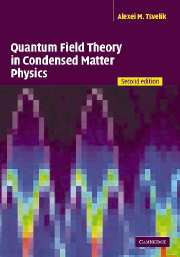Book contents
- Frontmatter
- Contents
- Preface to the first edition
- Preface to the second edition
- Acknowledgements for the first edition
- Acknowledgements for the second edition
- I Introduction to methods
- II Fermions
- III Strongly fluctuating spin systems
- IV Physics in the world of one spatial dimension
- Select bibliography
- Index
Preface to the first edition
Published online by Cambridge University Press: 05 May 2010
- Frontmatter
- Contents
- Preface to the first edition
- Preface to the second edition
- Acknowledgements for the first edition
- Acknowledgements for the second edition
- I Introduction to methods
- II Fermions
- III Strongly fluctuating spin systems
- IV Physics in the world of one spatial dimension
- Select bibliography
- Index
Summary
The objective of this book is to familiarize the reader with the recent achievements of quantum field theory (henceforth abbreviated as QFT). The book is oriented primarily towards condensed matter physicists but, I hope, can be of some interest to physicists in other fields. In the last fifteen years QFT has advanced greatly and changed its language and style. Alas, the fruits of this rapid progress are still unavailable to the vast democratic majority of graduate students, postdoctoral fellows, and even those senior researchers who have not participated directly in this change. This cultural gap is a great obstacle to the communication of ideas in the condensed matter community. The only way to reduce this is to have as many books covering these new achievements as possible. A few good books already exist; these are cited in the select bibliography at the end of the book. Having studied them I found, however, that there was still room for my humble contribution. In the process of writing I have tried to keep things as simple as possible; the amount of formalism is reduced to a minimum. Again, in order to make life easier for the newcomer, I begin the discussion with such traditional subjects as path integrals and Feynman diagrams. It is assumed, however, that the reader is already familiar with these subjects and the corresponding chapters are intended to refresh the memory. I would recommend those who are just starting their research in this area to read the first chapters in parallel with some introductory course in QFT. There are plenty of such courses, including the evergreen book by Abrikosov, Gorkov and Dzyaloshinsky.
- Type
- Chapter
- Information
- Quantum Field Theory in Condensed Matter Physics , pp. xi - xivPublisher: Cambridge University PressPrint publication year: 2003

